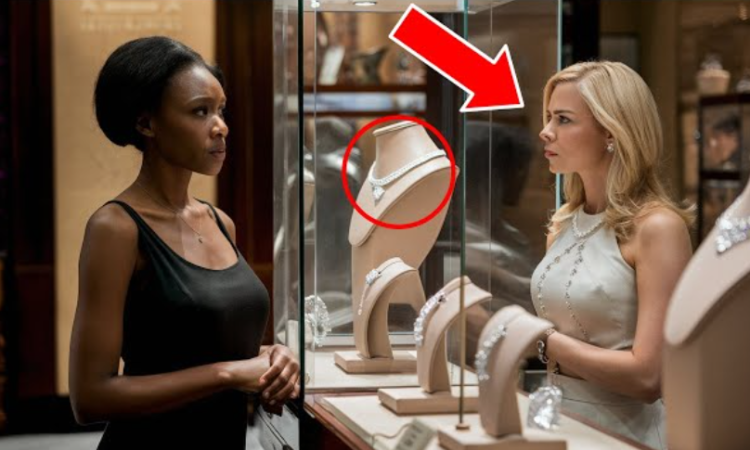
Amid the hustle and elegance of downtown Chicago, Grace Williams Jewelry Store shone like a beacon of luxury and sophistication. Known for its refined collection and impeccable service, the store was a haven for those seeking jewelry that not only adorned but also told stories of beauty and prestige.
Grace Williams, the founder and owner of the jewelry store, was a 42-year-old Black woman who fought hard to build her wealth. She was an elegant yet humble woman, an extraordinary and successful entrepreneur. Her vision for the store was clear: to create a space where every customer felt unique and valued. With a reputation built on respect and dedication, Grace made sure her team shared the same values she did.
Emily Carter, a newly hired young woman, was excited about the opportunity to start her career at the renowned jewelry store. Full of enthusiasm and ambition to stand out, Emily was ready to dive into the world of luxury and high fashion.
Emily was beaming as she walked through the doors of the elegant jewelry store in the heart of Chicago. It was her first day on the job, and the anticipation of a new phase in her life made her heart race. She had spent weeks preparing for this opportunity, studying jewelry and the history of the company, determined to impress her superiors.
Upon entering the store, she was greeted by Rachel Thompson, the manager, a middle-aged woman with a confident demeanor and a welcoming smile. Rachel had keen eyes and a natural elegance that reflected the sophistication of the store.
“Good morning, Emily. Welcome to our team,” Rachel said, extending her hand.
“Thank you, Rachel. I’m very excited to start,” Emily replied, shaking the manager’s hand and trying to contain the excitement bubbling on her face.
Rachel smiled, recognizing the enthusiasm of the new employee. “Today we’ll focus on showing you the store’s policies and how we serve our customers. We have a reputation to uphold, and it’s important that everyone feels welcomed and valued here.”
Emily nodded eagerly. “Of course, I understand. I want to do everything as best as I can.”
Rachel began giving a tour of the store, explaining the daily procedures and the details of the various jewelry collections. “Here we have our most expensive pieces,” she said, pointing to a gleaming display full of diamonds and precious stones. “And here are mid-range items, which are also quite popular.”
As they moved from one section to another, Rachel emphasized the importance of treating all customers with the same respect and attention. “It doesn’t matter how a customer is dressed or how much money they seem to have. Our goal is to ensure that every person who walks in here feels special and appreciated.”
Emily agreed, but internally, she had her own ideas about who deserved more attention. She had grown up in a small town where appearances often dictated the treatment one received, and these unconscious biases still influenced her views.
Rachel then led her to the service counter. “This will be your main station. It’s where you’ll have the chance to interact directly with customers. Remember, the first contact is crucial. A smile and a friendly greeting can make all the difference.”
“Got it,” Emily said, absorbing every word. She was determined to stand out and show that she could handle any situation.
The morning flew by as Rachel continued to guide Emily, who was getting familiar with the environment and the products. When lunchtime came, Rachel suggested a break.
“Let’s go have lunch. I want to learn more about you and also give you the chance to ask questions.”
Sitting in a small café near the store, Rachel and Emily started chatting more informally. Emily shared about her childhood, her education, and how she always dreamed of working with jewelry.
“I’ve loved jewelry since I was a child. My grandmother had a small collection, and I was fascinated by each piece,” Emily said with a nostalgic smile.
Rachel listened attentively. “It’s good to hear that. Passion for what we do is essential, and it sounds like you have a great start.”
“Yes, I really love it, and I’m very grateful for this opportunity,” Emily responded sincerely.
After lunch, they returned to the store, and Emily began attending to the first customers under Rachel’s supervision. Most interactions went smoothly, but Rachel continued to observe, ready to step in if necessary.
“You’re doing well, Emily. Just remember to always stay calm and be patient, even when customers are demanding or difficult,” Rachel advised.
“Thank you, Rachel. I’ll remember that,” Emily said, feeling more confident with each interaction.
At the end of the day, Rachel gave an overview of Emily’s first day. “You did very well. I’m impressed with your willingness to learn and your positive attitude.”
“Thank you, Rachel. I’ll keep striving,” Emily promised, feeling motivated by the encouraging words.
As she left the store that day, Emily felt hopeful and confident. Little did she know her determination and the lessons from Rachel would be tested in ways she never imagined.
The next day, Emily returned to work. She wanted to show her effort and prove she had learned from Rachel. However, Emily had her own beliefs about the best potential customers. She believed she should only serve clients who, according to her criteria, had the highest purchasing power.
The jewelry store was bustling with customers looking for something special. The store, with its luxurious and welcoming atmosphere, was a refuge for those seeking fine jewelry. Emily, newly hired and eager to prove her worth, believed she should make an immediate sale of an expensive piece to gain recognition for her work. Thus, she started selecting which customers to give her attention to based on her judgment of their purchasing power. Those she deemed less affluent received little to no attention from her.
Emily was busy assisting customers under the guidance of Rachel Thompson, who was out of the office handling administrative matters. The store’s bell chimed softly, announcing the arrival of a new customer. Emily looked up and saw a woman walk in. The Black woman was dressed in a simple black dress, with no makeup and a discreet style. Emily quickly made a snap judgment, forming a prejudiced opinion. With no visible jewelry and a modest appearance, the Black woman seemed out of place in the high-end store.
“Good morning,” Emily said, trying to hide her disdain. “Can I help you with something?”
The woman smiled gently. “Yes, I’m looking for a special necklace for an important event. Something elegant but not too flashy.”
Emily, barely concealing her contempt, pointed to the mid-range jewelry section. “You can start here. We have some pretty and more affordable options.”
The customer didn’t seem bothered by the suggestion. “Actually, I’d like to see some of your more exclusive pieces, if possible. Something truly special.”
Emily mentally rolled her eyes, finding the woman’s request a bit absurd. “If you insist,” she responded in an impersonal tone. She took out a diamond necklace from the luxury display and showed it with evident disinterest. “This is one of our most expensive models. It’s a classic design.”
Emily believed she was wasting her time with the woman, thinking she couldn’t possibly afford such a necklace. The customer examined the necklace attentively, but Emily’s lack of enthusiasm was evident. She didn’t provide any details or attention to the woman.
Holding the necklace with an appreciative gaze, the woman began to speak about it. “This necklace has a fascinating history. I personally acquired it for our collection. The combination of diamonds and the design is truly unique. Every piece I choose is carefully selected to ensure it has a special touch.”
Emily, surprised by the customer’s knowledge, frowned, trying to understand why she seemed so well informed. The woman continued with a gentle and confident tone.
“I am Grace Williams, the owner of this jewelry store. This piece is one of the many I acquired for our store, ensuring that our customers have access to the most exclusive and high-quality jewelry.”
The shock was immediate for Emily. Her face turned pale as the reality of the situation set in. The woman she had treated with disdain and ignored was, in fact, the store’s owner. Emily felt as if the ground had disappeared beneath her feet. Grace, with a calm and firm expression, looked directly at Emily.
“I decided to visit the store informally to check the quality of our customer service. The treatment I received was unacceptable. Every customer, regardless of their appearance or style, deserves to be treated with respect.”
Emily tried to compose herself, her eyes filled with shame. “Mrs. Williams, I… I’m sorry. I judged you by your appearance and didn’t provide the service you deserve.”
“Yes, Emily. Exactly what I don’t want to happen here. I do not tolerate people being treated or judged by their skin color or the way they dress,” Grace continued, with a softer but firm tone. “It’s important to understand that every customer who walks into this store must be treated with dignity and consideration. The way you treated me and possibly other customers reflects directly on our reputation. If you intend to continue working with us, you need to change this behavior immediately.”
Rachel, who had been watching the situation unfold with a look of disappointment, finally intervened. “Emily, let this be a lesson for you. Respect for our customers is fundamental. We must always maintain the highest standards in our service.”
Emily, with tears in her eyes and a trembling voice, tried to apologize again. “I am truly sorry, Mrs. Williams. I will do my best to correct my behavior.”
Grace, with a tone of understanding, replied, “I believe everyone has the capacity to learn and improve. I am willing to give you a second chance, but you will need to undergo sensitivity and diversity training. It’s crucial that you understand the value of respect.”
Rachel confirmed, offering support to ensure Emily would be properly trained. “We will ensure this doesn’t happen again and that all
customers receive the service they deserve.”
Emily, still embarrassed, accepted the opportunity to correct her mistakes. Grace’s revelation not only surprised her but also made her deeply reflect on her attitudes and biases. With a new understanding of the importance of respect and equality, Emily was determined to prove she could change and become a more conscientious and dedicated employee.
The following days at Grace Williams Jewelry Store were marked by an atmosphere of tension and introspection. Emily Carter, now aware of the mistakes she had made and the consequences of her actions, was determined to transform her approach. With the sensitivity and diversity training scheduled, she was ready to face the harsh reality of her prejudices and work towards redemption.
The store continued to operate normally, with Rachel Thompson keeping a close eye on operations and ensuring the service met the high standards of the jewelry store. Grace, in turn, was involved in other commitments but always intended to oversee Emily’s transformation. Grace believed that Emily was young and had a good heart; she just needed to be guided in the right direction.
The training, led by a diversity and inclusion specialist, was intense and eye-opening. Emily actively participated in the discussions and exercises, confronting her own beliefs and learning about the importance of treating all people with dignity and respect. She began to understand not only her own shortcomings but also the experiences of others who faced daily discrimination.
During one of the sessions, the facilitator asked participants to share moments when they felt excluded or disrespected. Emily listened attentively, realizing the depth of others’ experiences. She understood how her unconscious behavior had impacted others and committed herself to change.
Meanwhile, Grace continued to visit the store regularly, observing Emily’s progress with a critical eye. On one of these visits, Grace decided to interact directly with Emily to see how she was applying what she had learned.
“Good morning, Emily,” Grace said with a smile. “How is your training going? Have you found ways to apply what you’ve learned?”
Emily, now more confident and attentive, replied, “Good morning, Mrs. Williams. The training has been very enlightening, and I’ve been trying to apply what I’ve learned to my customer service. I’m more aware now and strive to treat everyone with respect, regardless of their appearance.”
Grace nodded, pleased with the response. “I’m glad to hear that. Respect and empathy are fundamental in any workplace, especially in a store like ours, where every customer should feel valued.”
Grace was a kind woman with unquestionable leadership. She knew that a good leader should guide, direct, and train their employees. That’s why her ventures were so successful.
From that point on, Emily made a conscious effort to improve her customer service. She began interacting with customers in a warmer, more attentive manner, without preconceived judgments. Her change in attitude was noticed not only by Rachel but also by the customers, who commented on the improved service.
A week later, Rachel scheduled a meeting with Emily to discuss her progress. Emily entered the office with an expression of determination and pride.
“Rachel, I’d like to share with you how this change has been for me,” Emily began. “The training made me realize how wrong I was. I’ve learned to be more empathetic and not judge customers based on their appearance. I’ve been striving to apply these lessons and feel like I’m improving.”
Rachel smiled, acknowledging Emily’s effort. “You’ve done an excellent job, Emily. Transformation isn’t easy, but you’re showing a real commitment to change. That’s important for our store and for your own personal growth.”
As the conversation continued, Grace entered the store again for a follow-up visit. Observing Emily interacting with a customer with genuine enthusiasm, Grace felt a sense of pride. Emily’s transformation was becoming a reality, proving that learning and change could indeed happen.
Grace approached Emily and Rachel with a satisfied smile. “Emily, I’m impressed with your progress. It’s gratifying to see you applying what you’ve learned in treating our customers with the respect they deserve.”
Emily, visibly moved, responded, “Thank you, Mrs. Williams. Your opportunity for a second chance was very important to me. I’ve learned to value every customer and treat everyone with dignity.”
Grace concluded with an encouraging tone, “Remember, true wealth isn’t in the jewelry we possess but in the value we give to the people around us. Respect and empathy are the greatest qualities we can cultivate.”
Emily agreed, understanding the depth of Grace’s words. She knew that true transformation came from within and was determined to continue being the best version of herself. With Rachel’s support and Grace’s guidance, Emily was becoming not only an exemplary employee but also a more conscious and empathetic person.
Work at Grace Williams Jewelry Store continued with a renewed energy and commitment. Emily, with her new perspective, was ready to face any challenge with respect and dignity. And so, the most valuable lesson was learned: the true gem wasn’t in the store’s shiny pieces but in the ability to treat people with the value and respect they truly deserved.




